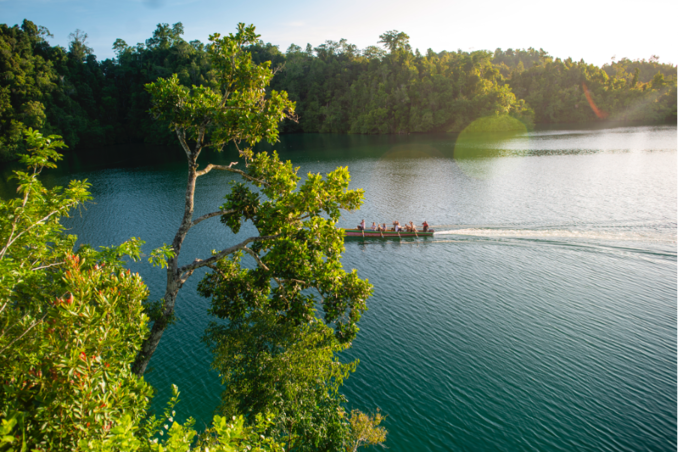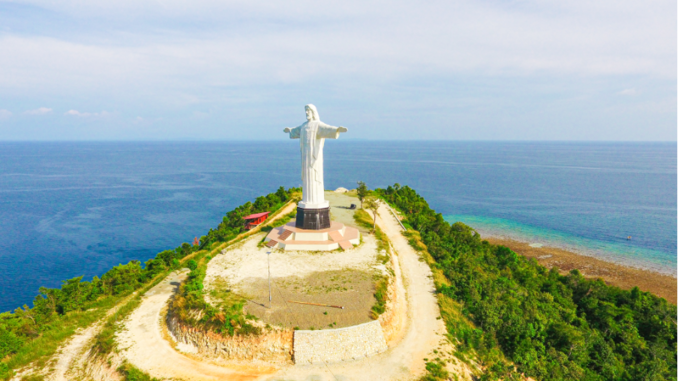Word: Ayu Arman

Manabay Bay. A bay with Tosca green sea waters surrounded by shady trees. This bay is located in Sarawandori Village, Kosiwo District, adjacent to Mioka Bay. The water is calm and clear so that it becomes a natural swimming pool for the community and tourists. In this bay, you can also do rowing activities, jet skiing, banana boats, water bikes, flying fish, and others.
Manabay Bay has actually been famous for a long time by the people of Serui City. The bay is well-developed by the local people. The provincial government has been working with the customary rights owner of this bay land to build and organize it into a city tourism area because the location is only fifteen minutes from Serui City. We made a road for access to the bay, which is in the hills and prepared facilities and amenities such as a relaxing place to enjoy the view, a coffee shop and a car park area. We have handed over the management to the people of Sarawandori.

Manabay Bay has actually been famous for a long time by the people of Serui City. The bay is well-developed by the local people. The provincial government has been working with the customary rights owner of this bay land to build and organize it into a city tourism area because the location is only fifteen minutes from Serui City. We made a road for access to the bay, which is in the hills and prepared facilities and amenities such as a relaxing place to enjoy the view, a coffee shop and a car park area. We have handed over the management to the people of Sarawandori.

Yapen Island’s marine tourism also presents cultural wisdom to the local community. Among other things, traditional villages over water in Ansus, Kampung Serui Laut, Nundawimpi, Ambai, Saweru, Papuma, Kairawi, Randawaya, and Narei. In Ansus Village, for example, it has its own uniqueness with boat transportation carved with various motifs. This is because the people of Ansus Island have long been known as distant sea explorers by boat. They passed on the knowledge of the sea by using their traditional calendar called kong, a rope tied with a knot to determine days, weeks, months, and even years.
Culture is the element of tourism that most attracts tourists. This is because, through culture-based tourism, tourists can understand the dynamics of cultural development, local wisdom, and the creations, works and initiatives of a community and endeavors of a community.
In addition to nature and maritime tourism, there are many trajectories of this nation’s history that were moved from the Yapen Islands. Thus, we also develop historical and religious tourism spots. Cultural tourism includes various activities such as watching art performances, seeing cultural festivals, visiting traditional settlements with their traditional houses, visiting museums, and visiting heritage tourism sites.
First, the site of Sam Ratulangi’s battle in Serui City. The figure, whose full name is Gerungan Saul Samuel Jacob Ratulangi is a national hero who was exiled by the Dutch government in Serui. He presented various political course activities that instilled the spirit of nationalism in the Serui people. Together with Serui figures such as Silas Papare, Berotabui, Stevanus Rumbewas, Hermanus Wayoi, and other young figures, Sam Ratulangi pioneered the rise of nationalism through the Irian Indonesian Independence Party (PKII) a year after Jakarta declared Indonesia’s independence. Serui was also the basis for the struggle to return West Irian to Indonesia’s lap. The residence and struggle of Ratulangi have become a history museum in the center of Serui City, which can be visited by historical researchers or tourists.

Second, the Monument Kasih Ari Sai (Mokas). We know that missionaries and the church play a major role in spiritual enlightenment and education in the land of Papua. The existence of the church in Yapen began with the arrival of zendeling (evangelist), namely Pastor Ottow and Pastor Geissler on February 5, 1855 on Mansinam Island.
Approximately half a century later, in 1912 to be precise, the gospel message reached Yapen. At that time, the Tedeman ship was assigned to install beacon lights on several headlands in the Yapen area and several church teachers participated. The Utrecht zending boat came from Mansinam carrying teachers from Maluku. They are church teachers as well as people’s schools. From the arrival of the evangelists, a great momentum of change occurred in Yapen, more specifically in Serui City.
Many boarding-style schools were built, from elementary to vocational schools, including Jongens Vervolgs School for boys, Meisjes Vervolgs School for girls. The schools are equivalent to grades 4 to 6 SD. There was also a teacher’s school (Opleiding voor Volkschool Onderwyzer), congregational teacher’s school, pastor’s school, evangelist’s school, nursing and midwifery school and agricultural course (Landbouw Practicek Course) so that Serui in the Dutch era was called the city of education.

To commemorate the entry of the Bible and the struggle of the missionaries to Yapen Island, the local government built the Mokas or Monumen Kasih Arui Sai. A statue of the Lord Jesus with a height of 33 meters in the Tanjung Ambori area, Serui Laut. This monument is a symbol of an invitation to the people of the Yapen Islands to remember God’s love that always blesses our lives. Also, as a reminder for the Yapen people not to forget the missionary struggles in Papua by bringing the gospel news and salvation taught by Jesus Christ to always spread love to fellow human beings.
This monument is also now an icon of the Yapen Islands which is not only enjoyed as an art form, but also as a religious tourism destination with beautiful sea views. With well-developed infrastructure, now you can come to the Yapen islands at any time to enjoy the unspoiled natural beauty of the Yapen islands. Come on, prepare your trip!
